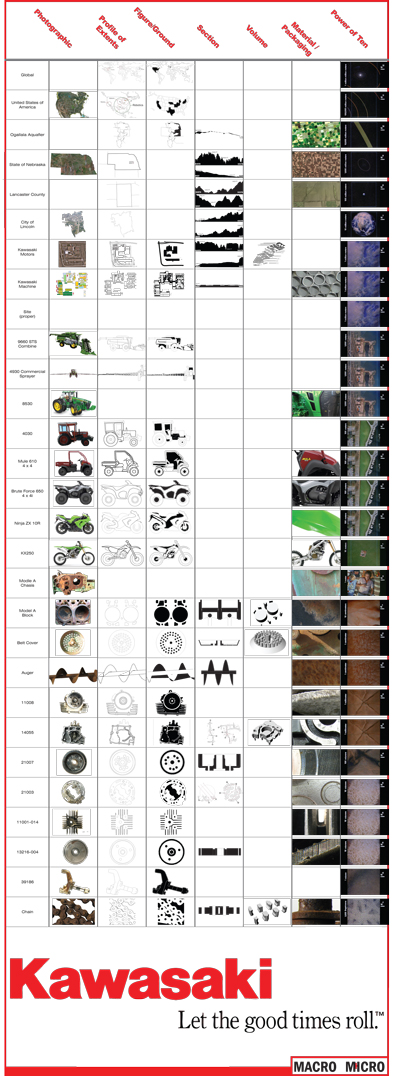anchor
Terminal Project .02
“Vehr ist the money Lebowski?“ The critique was both inspiring and tangential. What to do? take on pure formalism or functional based architecture? Before I go into this my critics were:
Keith Sawyers
Jeff Day
Martin Despang
Hyun Tae Jung
Chris Ford
In summary, I have been exploring my site (roughly 56 city blocks) on a macro and micro level. In other words, zooming way out to a global scale and zooming in to the products that Kawasaki manufactures along with various agricultural equipment. These are all welded into a matrix that lines up the components on an equal benchmark. The matrix protects against a hierarchy that usually exists in an architectural project. The question is what do I do with the information? My critics were split, some wanted the studies I did of the interior program to be rearranged and begin to influence the new R + D attachment and others wanted the aesthetic and form of the machine to be the propellant. I believe that both can happen. The OMA side of me enjoys stacking, rearranging, and wrapping the program in a skin; the other has an appreciation with the machine aesthetic like Wes Jones Partners. Which brings me to another point; When did I start aligning myself with other architects? I've never believed in using precedents for my projects. Not because I think I need to invent something new, but I'd rather find my own way to a solution with out the influence of something built. I'd much rather reference an image of a baseball pitcher in mid-throw or a river hitting its equilibrium profile and flooding its banks to reset itself then another piece of architecture. Moving on... I believe a marriage of the form and function will work because the two, by association share these traits.
In the end, the terminal project has to be a piece of architecture to facilitate at a human scale, therefore, the program layering and stacking prepares me for a well working creation. The packaging (Heidegger's definition) can take advantage of the aesthetics of the machine. Mental imagery produced by the word “machine” might indicate a very explicit and overly complex moving part; however this is too literal and archaic of an interpretation. Technology has evolved from mere dynamic parts. Using the latest technology is
what it wants.
AJ







1 Comment
great diagrams
Block this user
Are you sure you want to block this user and hide all related comments throughout the site?
Archinect
This is your first comment on Archinect. Your comment will be visible once approved.